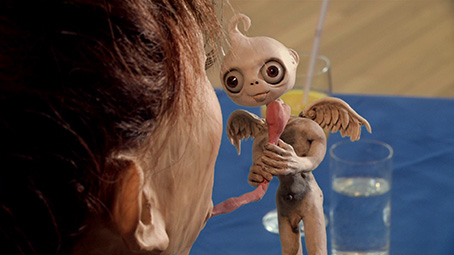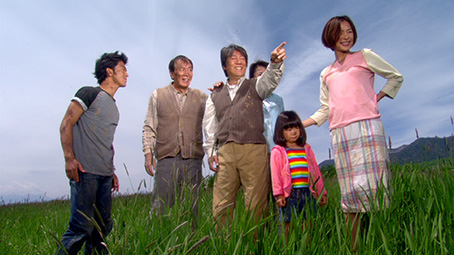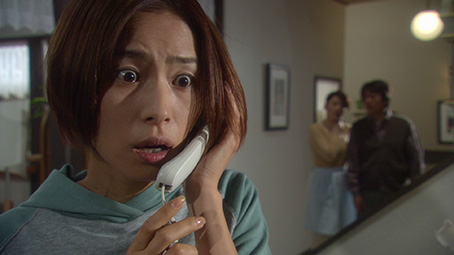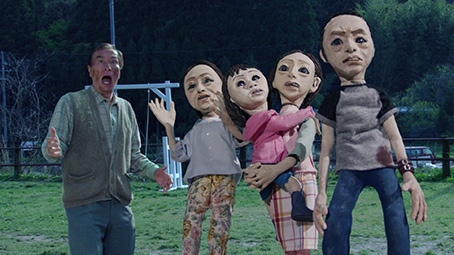|
Note: This review has been updated from our previous coverage of the 2003 Tartan DVD release.
It all starts like this. In a brightly lit restaurant, a girl dips a spoon into her soup and instead of finding croutons discovers it is home to a small sprite-like creature. This live action opening then makes a sudden and unapologetic switch to claymation. As the girl screams in horror, the sprite looks into her gaping mouth and falls instantly in love with her vibrating uvula, which he tears out and flies off with to the twang of a jovial Celtic folk tune. The sprite comes to earth, looks lovingly at the stolen uvula and proceeds to eat it, and is devoured by a crow. As bits of the sprite tumble to the ground, one of its eyes is grabbed by a battered old cloth doll, which transforms into a gnarly-toothed predator and promptly attacks and eats the crow. Meanwhile an egg is swallowed and regurgitated by a snake and cracks open to reveal another sprite, which just has time to wonder at the miracle of life before it too is attacked by a crow, which flies off, defecating on an old man's forehead as it passes. As claymation transforms back to live action, the man angrily hurls a lump of wood through the air and brings down the crow. And we haven't even reached the opening titles yet.
If this first sequence doesn't send your eyebrows skyward then what follows certainly will, for even in these days of generic cross-fertilisation, Audition, Ichi the Killer and 13 Assassins director Miike Takashi's brain-battering melding of family drama, horror, animation, romance, comedy and musical is nigh-on impossible to easily categorise, especially as even the generic conventions suggested by these labels are themselves intermittently turned on their heads.

The plot has actually been lifted from the 1998 Korean black comedy The Quiet Family [Choyonghan kajok], which was the debut feature of director Kim Jee-woon, who later made his name with the likes of A Tale of Two Sisters, A Bittersweet Life and my personal favourite, I Saw the Devil. I've never managed to catch The Quiet Family so I'm not in a position to make direct comparisons, but those who have appear to hold it in high regard. The news that the venerable Tom Mes – a man with an encyclopaedic knowledge of Asian cinema and who has written two books on the films of Miike Takashi – also hasn't seen it made me feel a little better about this unfortunate omission.
In this take on the story, the titular Katakuris are a family that have chosen to abandon ordinary suburban life and run a country inn, but have selected one so off the beaten track that it starts to look like no-one will ever come across it. When someone finally does, it turns out that he has chosen this spot to commit suicide, and does so by stabbing himself in the throat with one of the inn's own room keys. Fearing the negative publicity this might generate, the family bury his body in a nearby wood, but this proves to be just the start of their problems.
Once he's finished with the bonkers claymation opening, Miike introduces the main characters with a string of effective post-modernist flourishes, smartly drawing a picture of a less-than-perfect family unit in the space of a couple of minutes: son Masayuki (Takeda Shinji) has just finished a stretch in jail for theft; daughter Shizue (Nishida Naomi) is given to falling in love with the wrong man at the drop of a hat; running the inn was a long held dream for father Masao (Sawada Kenji) and the lack of customers is making him increasingly depressed; and grandfather Jinpei (verteran actor Tanba Tetsurô) views the whole enterprise with cranky annoyance. Despite this, there's a squeaky clean cheerfulness to the proceedings, emphasised by the brightly colourful digital cinematography and the sunny mountain scenery. But the weirdness soon begins to kick in. Watching TV one night, the family are captivated by a ludicrously enthusiastic TV presenter (played by respected actor Takenaka Naoto) who fights to maintain his composure as a large insect crawls up his nose, and a channel change transforms him into a drag act singing a peculiar song about his skull (one of the occasional peculiarities of the subtitles has this incorrectly translated as "Dem Bones..." despite sounding nothing like that particular song).

The Happiness of the Katakuris is a work of inspired madness, and one that is seriously difficult to resist. I've seen it described as a combination of Shallow Grave, Night of the Living Dead and The Sound of Music, but even this won't prepare you for what Miike delivers – indeed, by the time the first character bursts into song, you've almost forgotten you're also watching a musical. Although the first number is actually delivered by the suicidal guest (played by film critic Shiota Tokitoshi, an early champion of Miike's cinema who has also appeared in a number of his films), it's with the discovery of his death that thing really kick off, with the family exploding into a rock number that has them running about, hands held over their eyes in theatrical expressions of shock and bellowing out their dismay at what has occurred. Coming out of nowhere, this made me laugh out loud so hard I fell off my chair. From here on in the numbers come thick and fast. None are likely to find themselves on too many lists of classic movie musical moments, but they are always enjoyable and sometimes unexpectedly catchy (the final song in particular I caught myself singing for some time afterwards). Comically, only about half of the cast can really hold a tune, despite the fact that Sawada Kenji started his career as a singer in a popular post-Beatles pop group and Imawano Kiyoshiro is a rock star of some fame and repute who was once dubbed 'Japan's King of Rock'. The musical silliness peaks with a wondefully daffy fantasy karaoke sequence, where the audience is invited to sing along as the Japanese lyrics are presented on screen in the manner of a bar-room karaoke machine. When I stopped laughing, I actually found myself joining in – at least it gave me the chance to practice my diction.
And then there's the dancing. Although choreographed, the actors are not professional dancers (well I'm presuming they're not...) and all of the dance sequences have a charmingly improvised quality, with the individual family members rarely in sync with each other, all seemingly aware of what they have to do but with no eye on what their fellow performers are up to. Bizarrely, this actually adds to the fun, making the dances feel a lot less less artificial than their more slickly performed equivalent. It also makes it oddly easy to believe that the Katakuris are a family who regularly burst into song or dance when the emotion takes them, adding to the sense that this is a family that will stick together no matter what fate may throw at them. Indeed, the strength of the family unit as emerges as the central theme of the film, and here we have a family that, despite its troubled past, will live, work, sing and dance together, and will even bury the bodies of dead guests together as well.

Miike draws on a variety of sources here. The Sound of Music is perhaps the most obvious, but there is more than a hint of Dancer in the Dark about one of the numbers, and on his commentary track Miike suggests that a lot more was borrowed from that and other films, though its hard to be sure whether he's being completely serious and I have a feeling that even Lars von Trier would struggle to recognise those elements as they play out here. A later dance with zombies recalls John Landis' Thriller music video for Michael Jackson, and the animation even has a Svankmajer quality to it in places, something confirmed again by the extra features. In this film, though, the switch from live action to claymation seems less governed by a surrealist sensibility than the impossibility of staging big action scenes on a low budget – on his commentary, Miike confirms that the second animated sequence was necessary because "an old man and a rock star with a weak body couldn't possibly do an action scene," and that the claymation finale was the result of having scripted a special effects scene that he simply could not afford to stage effectively with CG. In the end you don't feel cheated because this just adds to both the film's stylistic potpourri and its unwavering energy and sense of fun, and in that sense bonds it to Alex Winter and Tom Stern's 1993 Freaked, whose intermittent switches from live action to clay animation also had a cheery 'what-the-hell?' quality. Yet having hit us with so much stylistic, generic and narrative game-playing, Miike's final trick is to deliver an ending that is both quietly unexpected and genuinely moving, neatly rounding off a deliciously offbeat and hugely enjoyable multi-genre work that should be hunted out by anyone with a fondness for the cheerfully absurd.
By the way, Katakuri is an apparently quite rare plant whose roots can be made into starch. Thought you might like to know that.
Back when I reviewed Tartan's DVD release I remarked that it looked almost definite that the film had been shot digitally. Watching it again a few years later on this new 1080p transfer on Arrow's dual format release I'm wondering why this was not patently obvious to me from the start. According to Tom Mes, Miike was working with one of the very first 24p HD cameras here, and while the level of detail is often on a par with film, the serious burn-outs on some of the highlights scream digital from the rooftops. While Miike appears to have made this part of the film's aesthetic, it does mean that you won't get the sort of eye-popping punch you'll find on a Viper-shot Hollywood feature like Zodiac. The contrast also varies a little, with black levels occasionally softening in darker scenes, but for much of the time the balance is nicely struck and the digital feel does add nicely to the film's carefully crafted air of artificiality. This is carried through to the colour scheme, in which naturalism has been given a slightly pastel makeover and brighter colours can sometimes explode (the blue that soaks the room in which the first guest dies is a good example). Comparing the transfer side-by-side with the Tartan DVD, the crispness here is a serious step up. A damned fine job.

The Linear PCM 48K stereo track is also in fine shape, with clear reproduction of the dialogue, a very decent dynamic range and a lively rendition of the musical numbers. The instrumentation of the songs in particular is very clear.
The Optional English subtitles are crisply rendered and appear to be from the same translation as those on the previous Tartan DVD.
The Making of the Katakuris (30:42)
One of a number of features ported over from the Tartan DVD release, this enjoyable mixture of interview and behind-the-scenes footage shows Miike and his crew at work on the film, which looks as if it was as much fun be involved in as it is to watch – Miike particularly, with his hip-hop look and boundless energy, seems to be having the time of his life throughout. This is a really worthwhile extra – Miike is a compelling figure and it's great to see how this essentially low budget production pulled off some of its more elaborate sequences and gags.
A section titled Interviews is headlined by a newly filmed chat with Miike Takashi (38:59), which is subtitled Violent 'Til I Die (this is explained in the interview), in which he talks about how the film came to be, casting and working with such renowned actors, the choreography (he insisted on minimal rehearsals so that the dancing wouldn't be too polished), the animation, and the industry doors that were opened for him by the film. He claims it was received indifferently in Japan and was seen as being "too irreverent or stupid," and apparently has still not been widely seen there. He also makes a very pertinent point about being a little inventive with remakes: "The original story existed already so there was really no point in making a similar film. We can all watch the original." Absolutely.

The rest of the Interviews are 4:3 framed snippets ported over from the DVD release. Actors Sawada Kenji (5:00), Matsuzaka Keiko (2:48), Imawano Kiyoshi & Takeda Shinji (4:28), Nishida Naomi (2:19) and Tamba Tetsuro (4:04) talk about their work on their film, their co-stars and their director, while Miike Takashi (5:03) reflects on the story, the characters, transforming the story into a musical and the importance of family.
Animating the Katakuris (5:30)
A so-so look at the creation of the animation sequences that is centred around clay animation director Kimura Hideki, whose thoughts are delivered as scrolling text rather than voice over. This extra does confirm the Svankmajer connection, but doesn't actually show us much of the process of creating the animations themselves. A longer, more in-depth version of this would have been welcome.
Dogs, Pimps and Agitators (23:51)
A visual essay by Midnight Eye's Tom Mes – author of Agitator: The Cinema of Takashi Miike and Re-Agitator: A Decade of Writing on Takashi Miike – that takes us on a trip through Miike's film career. Illustrated with clips from the films under discussion (and there are no compromise poster and stills substitutions here), it's an utterly enthralling and well written piece, seductively narrated by the soft-spoken Mes, and left me wishing it was twice the length it is.
Trailer (1:44)
A rather neatly edited sell for the Japanese market.
TV Spot (0:20)
"Amazing musical! Family, horror, comedy!" Oh yes, this was made for Japanese TV all right.

Commentary by Miike Takashi
Miike actually shares the commentary chair with his friend Shiota Tokitoshi, the critic who championed his early work and who plays the inn's first victim. Conducted in Japanese with English subtitles and recorded for what sounds like the film's first American DVD release, it's an absolute riot. Miike especially has fun with the whole process of commenting on the film, suggesting that veteran actor Tamba Tetsurô can really bring down a crow with a thrown piece of wood and that this talent has regularly landed him work. "Shall I say something significant about the film?" he asks early on, and indeed does deliver plenty of useful information, especially for those not too familiar with Japanese culture, even about food being eaten in one scene. Both men know their genre cinema and reference some interesting lesser known works, and Miike supplies plenty of detail on some of the influences on his approach to the film. But it's the comical elements that makes it such fun, with the opening credits transformed into an impromptu Japanese lesson, and Miike suggesting that Tokitoshi will be playing Yoda in the next Star Wars film. When he worries that one joke won't work for non-Japanese viewers, Tokitoshi responds, "Well it's crap, even for Japanese audiences." Like the film itself, things get silliest during the karaoke sequence, when both men join in boisterously, applauding their own efforts as the song concludes. There is more than one mention of how the film will play in the US, and an unusual bit of international marketing from Miike: "There are many interesting sex businesses in Japan. So come to Japan and try them, by all means." There are a few brief dead spots, but Tokitoshi feeds Miike well and doesn't let him stay silent for long. Terrific.
What I didn't expect to find (and what was not present on Tartan's UK DVD) is an English Translated Commentary, a most peculiar concept that I have to assume was produced for the American DVD release, in which two unidentified American voices perform the above detailed commentary in English. Even though I found the whole thing a bit strange, the pair – whoever they are – do a surprisingly good job of sounding spontaneous and as if they were making the observations themselves. They even include convincing moments of hesitation, small naturalistic vocal stumbles and believable laughter. An odd concept, yes, but really well done.

Commentary by Tom Mes
A newly recorded and more fact-based commentary than the one detailed above, but still an essential extra brimming with information about the film, the actors (whose careers are outlined in detail), the director and more. Mes has one of those voices I could listen to all afternoon and his knowledge of Miike's work and this film in particular (it was the first Miike film he was on set for part of the filming of) is on a par with Bey Logan on martial arts cinema and every bit as information busy. Another excellent inclusion.
Booklet
A busy 40-page full colour booklet that boasts three entertaining essays on the film and Miike-san: Katakuris and Corpses by Johnny Mains; The Rock-and-Roll Horror Picture Show by Stuart Galbraith IV; and The Unhappiness of the Quiet Family by Grady Hendrix, which compares Miike's remake to Kim Jee-woon's original. Also included is an interview with Miike by the too perfectly monikered Sean Axmaker, plus credits for the film and stills.
The best horror musical of recent years (and there have been so many...) is also a good natured black comedy and a hymn to the strength of the family unit, and serves as a timely reminder that true happiness does not have a market value. A bizarre but imaginative one-off even by Miike's standards, The Happiness of the Katakuris is nonetheless one of his most enjoyable films, and within the restrictions imposed by the digital source material, Arrow have once again done it proud, porting over the best extras from the previous DVD release and adding a couple of choice ones of their own. Cheerfully recommended.
The Japanese convention of surname first has been used for all Japanese names in this review.
|